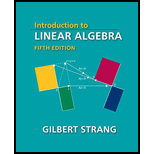
(a)
A matrix with column space contains
The required matrix is
Given:
Column space is
Calculation:
Calculate the column numbers and row numbers individually,
Therefore, the required matrix formed is
(b)
A matrix with column space has basis
The required matrix would be impossible to create because the value of addition of dimensions is not 3.
Given:
Column space has basis
Calculation:
To construct a matrix, the dimension of the column space and the dimension of the nullspace must sum up to 3, which is not possible with the column space has basis
Therefore, the required matrix is not possible.
(c)
A matrix with dimension of nullspace
The required matrix is
Given:
Dimension of nullspace
Calculation:
The dimension of nullspace is one more than the dimension of left nullspace.
Therefore, the required matrix could be formed as
(d)
A matrix with nullspace contains
The required matrix is
Given:
Nullspace contains
Calculation:
The left nullspace contains
Therefore, the matrix formed is the required matrix is
(e)
A matrix when Row space
The required matrix is not possible.
Given:
Row space
Calculation:
Row space
Consider
However,
Therefore, the required matrix is not possible.
(b)
A matrix with column space has basis
The required matrix would be impossible to create because the value of addition of dimensions is not 3.
Given:
Column space has basis
Calculation:
To construct a matrix, the dimension of the column space and the dimension of the nullspace must sum up to 3, which is not possible with the column space has basis
Therefore, the required matrix is not possible.
(c)
A matrix with dimension of nullspace
The required matrix is
Given:
Dimension of nullspace
Calculation:
The dimension of nullspace is one more than the dimension of left nullspace.
Therefore, the required matrix could be formed as
(d)
A matrix with nullspace contains
The required matrix is
Given:
Nullspace contains
Calculation:
The left nullspace contains
Therefore, the matrix formed is the required matrix is
(e)
A matrix when Row space
The required matrix is not possible.
Given:
Row space
Calculation:
Row space
Consider
However,
Therefore, the required matrix is not possible.
(c)
A matrix with dimension of nullspace
The required matrix is
Given:
Dimension of nullspace
Calculation:
The dimension of nullspace is one more than the dimension of left nullspace.
Therefore, the required matrix could be formed as
(d)
A matrix with nullspace contains
The required matrix is
Given:
Nullspace contains
Calculation:
The left nullspace contains
Therefore, the matrix formed is the required matrix is
(e)
A matrix when Row space
The required matrix is not possible.
Given:
Row space
Calculation:
Row space
Consider
However,
Therefore, the required matrix is not possible.
(d)
A matrix with nullspace contains
The required matrix is
Given:
Nullspace contains
Calculation:
The left nullspace contains
Therefore, the matrix formed is the required matrix is
(e)
A matrix when Row space
The required matrix is not possible.
Given:
Row space
Calculation:
Row space
Consider
However,
Therefore, the required matrix is not possible.
(e)
A matrix when Row space
The required matrix is not possible.
Given:
Row space
Calculation:
Row space
Consider
However,
Therefore, the required matrix is not possible.
Want to see the full answer?
Check out a sample textbook solution
Chapter 3 Solutions
Introduction to Linear Algebra, Fifth Edition
 Algebra and Trigonometry (6th Edition)AlgebraISBN:9780134463216Author:Robert F. BlitzerPublisher:PEARSON
Algebra and Trigonometry (6th Edition)AlgebraISBN:9780134463216Author:Robert F. BlitzerPublisher:PEARSON Contemporary Abstract AlgebraAlgebraISBN:9781305657960Author:Joseph GallianPublisher:Cengage Learning
Contemporary Abstract AlgebraAlgebraISBN:9781305657960Author:Joseph GallianPublisher:Cengage Learning Linear Algebra: A Modern IntroductionAlgebraISBN:9781285463247Author:David PoolePublisher:Cengage Learning
Linear Algebra: A Modern IntroductionAlgebraISBN:9781285463247Author:David PoolePublisher:Cengage Learning Algebra And Trigonometry (11th Edition)AlgebraISBN:9780135163078Author:Michael SullivanPublisher:PEARSON
Algebra And Trigonometry (11th Edition)AlgebraISBN:9780135163078Author:Michael SullivanPublisher:PEARSON Introduction to Linear Algebra, Fifth EditionAlgebraISBN:9780980232776Author:Gilbert StrangPublisher:Wellesley-Cambridge Press
Introduction to Linear Algebra, Fifth EditionAlgebraISBN:9780980232776Author:Gilbert StrangPublisher:Wellesley-Cambridge Press College Algebra (Collegiate Math)AlgebraISBN:9780077836344Author:Julie Miller, Donna GerkenPublisher:McGraw-Hill Education
College Algebra (Collegiate Math)AlgebraISBN:9780077836344Author:Julie Miller, Donna GerkenPublisher:McGraw-Hill Education





